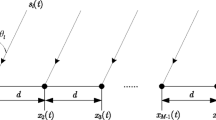Abstract
This work analyses the performance-complexity tradeoff for different direction of arrival (DoA) estimation techniques. Such tradeoff is investigated taking into account uniform linear array structures. Several DoA estimation techniques have been compared, namely the conventional Delay-and-Sum (DS), Minimum Variance Distortionless Response (MVDR), Multiple Signal Classifier (MUSIC) subspace, Estimation of Signal Parameters via Rotational Invariance Technique (ESPRIT), Unitary-ESPRIT and Fourier Transform method (FT-DoA). The analytical formulation of each estimation technique as well the comparative numerical results are discussed focused on the estimation accuracy versus complexity tradeoff. The present study reveals the behavior of seven techniques, demonstrating promising ones for current and future location applications involving DoA estimation, especially for 5G massivemimo systems.










Similar content being viewed by others
References
Godara, L.C. (2004). Smart Antennas, 1st edn. Boca Raton: CRC Press.
Monzingo, R.A., Haupt, R.L., Miller, T.W. (2011). Introduction to Adaptive Arrays. Raleigh: Scitech.
Fourtz, J., Spanias, A., Banavar, M.K. (2008). Narrowband Direction of Arrival Estimation for Antenna Arrays, 1st edn. Arizona: Morgan & Claypool.
Capon, J. (1969). High-Resolution Frequency-Wavenumber spectrum analysis. Proceedings of the IEEE, 57 (8), 1408–1418.
Reddy, V.U., Paulraj, A., Kailath, T. (1987). Performance Analysis of The Optimum Beamformer in The Presence of Correlated Sources and Its Behavior Under Spatial Smoothing. IEEE Transactions on Acoustics, Speech, and Signal Processing, 35(7), 927–936.
Schmidt, R.O. (1986). Multiple emitter location and signal parameter estimation. IEEE Transactions on Antennas and Propagation, 34(3), 276–280.
Godara, L.C. (1997). Application of antenna arrays to mobile communications, part II: Beam-forming and direction-of-arrival considerations. Proceedings of the IEEE, 85(8), 1195–1245.
Haykin, S. (1996). Adaptative Filter Theory, 3rd edn. New York: Prentice Hall.
Liberti, J.C., & Rappaport, T.S. (1999). Smart Antennas for Wireless Communications - IS-95 and Third Generation CDMA Applications, 1st edn. Upper Saddle River: Prentice Hall.
Gross, F.B. (2015). Smart Antenna with MATLAB, 2nd edn. New York: NY.
Barabell, A.J. (1983). Improving the resolution performance of eigenstructure-based direction-finding algorithms. ICASSP ’83. IEEE International Conference on Acoustics, Speech, and Signal Processing, 8, 8–11.
Roy, R., & Kailath, T. (1989). ESPRIT - estimation of signal parameters via rotational invariance techniques. IEEE Transactions on Acoustics Speech, and Signal Processing, 37(7), 984–995.
Haardt, M. (1997). Efficient One-, Two-, and Multidimensional High-Resolution Array Signal Processing, 1st edn. Munich: Shaker Verlag.
Balanis, C.A., & Ioannides, P.I. (2007). Introduction to Smart Antennas, 1st edn. Arizona: Morgan & Claypool.
Allen, B., & Ghavami, M. (2005). Adaptive array systems: Fundamentals and applications. West Sussex: Wiley.
Liang, J., & Liu, D. (2010). Passive Localization of Mixed Near-Field and Far-Field Sources Using Two-stage MUSIC Algorithm. IEEE Transactions on Signal Processing, 58(1), 108–120.
Liu, G., & Sun, X. (2014). Two-Stage matrix differencing algorithm for mixed Far-Field and Near-Field sources classification and localization. IEEE Sensors Journal, 14(6), 1957–1965.
Pal, P., & Vaidyanathan, P.P. (2010). Nested arrays: A novel approach to array processing with enhanced degrees of freedom. IEEE Transactions on Signal Processing, 58(8), 4167–4181.
Zhang, Y.D., Qin, S., Amin, M.G. (2014). Doa estimation exploiting coprime arrays with sparse sensor spacing. In ICASSP, IEEE International Conference on Acoustics, Speech and Signal Processing - Proceedings. Number 1 (pp. 2267–2271). Florence: IEEE.
Li, J., & Zhang, X. (2017). Direction of arrival estimation of quasi-stationary signals using unfolded coprime array. IEEE Access, 5, 1–1.
Mailloux, R.J. (2005). Phased Array Antenna Handbook, 2nd edn. Vol. 1. Artech House: Norwood.
Yang, X., Liu, L., Wang, Y. (2016). A new low complexity DOA estimation algorithm for massive MIMO systems. In 2016 IEEE international conference on consumer electronics-china (ICCE-china) (pp. 1–4). Guangzhou: IEEE.
Meng, H., Zheng, Z., Yang, Y., Liu, K., Ge, Y. (2016). A low-complexity 2-d DOA estimation algorithm for massive MIMO systems. In 2016 IEEE/CIC international conference on communications in China (ICCC) (pp. 1–5). Chengdu: IEEE.
Ferreira, T.N., Netto, S.L., de Campos, M.L., Diniz, P.S. (2016). Low-complexity DoA estimation based on Hermitian EVDs. Proceedings of the IEEE Sensor Array and Multichannel Signal Processing Workshop (pp. 1–5).
Zhang, K., Ma, P., Zhang, J.Y. (2011). DOA estimation algorithm based on FFT in switch antenna array. Proceedings of 2011 IEEE CIE International Conference on Radar, 2(4), 1425–1428.
Trench, W.F. (1989). Numerical Solution of the eigenvalue problem for hermitian toeplitz matrices. SIAM Journal Matrix Analisys Applications, 10(2), 135–146.
Hunger, R. (2007). Floating point operations in Matrix-Vector calculus. Technical report, Munich.
Cybenko, G. (1980). The numerical stability of the Levinson-Durbin algorithm for toeplitz systems of equations. SIAM Journal on Scientific Computing, 1(3), 303–319.
Haardt, M., Pesavento, M., Roemer, F., Nabil el korso, M. (2014). Subspace Methods and Exploitation of Special Array Structures. In Academic Press Library in Signal Processing: volume 3; Array and Statistical Signal Processing. 3rd edn. (pp. 651–717). Oxford: Academic Press.
Amdahl, G.M. (1967). Validity of the single processor approach to achieving large scale computing capabilities. Proceedings of the April 18-20, 1967, spring joint computer conference on - AFIPS ’67 (Spring) 483.
Culler, D., Singh, J.P., Gupta, A. (1997). Parallel computer architecture: a Hardware/Software approach Vol. 1. San Francisco: Morgan Kaufmann.
Golub, G.H., & Loan, C.F.V. (2013). Matrix Computations, 4th edn. Baltimore: Johns Hopkins University Press.
Acknowledgements
This work was supported in part by the National Council for Scientific and Technological Development (CNPq) of Brazil under Grants 304066/2015-0, and in part by CAPES - Coordenaçá3o de Aperfeiçoamento de Pessoal de Nível Superior, Brazil (scholarship), and by the Londrina State University - Paraná State Government (UEL).
Author information
Authors and Affiliations
Corresponding author
Additional information
Publisher’s Note
Springer Nature remains neutral with regard to jurisdictional claims in published maps and institutional affiliations.
Rights and permissions
About this article
Cite this article
Gentilho, E., Scalassara, P.R. & Abrão, T. Direction-of-Arrival Estimation Methods: A Performance-Complexity Tradeoff Perspective. J Sign Process Syst 92, 239–256 (2020). https://doi.org/10.1007/s11265-019-01467-4
Received:
Revised:
Accepted:
Published:
Issue Date:
DOI: https://doi.org/10.1007/s11265-019-01467-4




